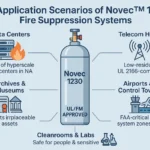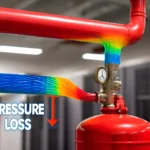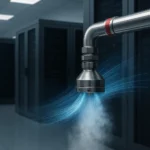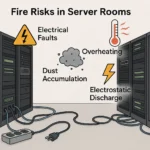Not all types of fires are the same—and treating them like they are can be deadly. The tragic 1911 Triangle Shirtwaist Factory fire, which killed 146 workers in New York, showed how fast a fire involving combustible materials can spiral out of control when the wrong type of extinguisher or method is used.
This and similar disasters led to the development of different classes of fire. Experts realized that fires behave differently depending on what fuels them—be it flammable liquids, electrical equipment, or combustible metals—and not all can be fought the same way.
Today, organizations like the National Fire Protection Association (NFPA) use these classifications to guide fire safety protocols across homes, schools, and construction sites. Understanding them isn’t just for firefighters—it’s essential knowledge for everyone.
So what exactly are the five types of fire extinguishers designed for different classes of fire, and how do they affect the way we protect ourselves? Let’s take a closer look.
The 5 Different Classes of Fire Explained

Fires are divided into five main types of fires based on what fuels them. Each class presents unique fire risks and requires a specific type of extinguisher to control it safely. Here’s a breakdown of each fire class and how to handle it effectively:
Class A – Fires involving ordinary combustibles
These fires involve paper wood, cloth, and some plastics—materials found in almost every home and office. They are among the most common fire risks, and water-based extinguishers like water mist or foam are typically effective. Always ensure the fire is fully extinguished to prevent re-ignition.
Class B – Fires involving flammable liquids
This category includes flammable liquids such as gasoline, oil, alcohol, and oil-based paints. These fires involve flammable substances that can spread rapidly and should never be extinguished with water, as it may cause the flames to spread. Use foam, CO2 fire extinguishers, or dry powder designed for liquid fuels.
Class C – Electrical fires
Caused by energized electrical equipment such as wiring, panels, or appliances, Class C electrical fires are particularly dangerous. Never use water, as it can conduct electricity and cause electrocution. Instead, use CO2 fire extinguishers or dry powder, which are non-conductive and safe for use on Class C fires.
Class D – Fires involving combustible metals
These fires occur with combustible metals like magnesium, titanium, sodium, or lithium, often found in construction sites, manufacturing facilities, and laboratories. Water and standard extinguishers can cause violent reactions. Only dry powder designed for burning metals should be used.
Class K – Fires involving cooking oils and fats
Common in commercial kitchens, restaurants, and food trucks, these fires result from overheated oils or animal fats. Using water can cause explosive flare-ups. Wet chemical extinguishers are specially formulated to cool the oil and create a soapy layer that prevents re-ignition.
Other Types
In the United States, these five different classes of fire comprehensively cover all recognized categories. While other countries may use slightly different classification systems (such as Class E in the UK for electrical fires), the U.S. includes those within Class C. It’s also important to recognize that some fire scenarios may involve multiple hazards—for example, fires involve flammable liquids ignited by faulty wiring—in which case, using a multi-class type of extinguisher rated for A-B-C classes is critical.
How to Extinguish Each Class of Fire
Effectively extinguishing a fire starts with understanding what you’re dealing with. Each of the different classes of fire requires a specific method of control, and using the wrong type of extinguisher can be dangerous.
For example, Class A fires, which involve paper wood, cloth, or certain plastics—common combustible materials found in homes and offices—are best handled using water mist, foam, or dry powder extinguishers. These work by cooling the material and cutting off oxygen to stop combustion.
In contrast, Class B fires, fueled by flammable liquids such as gasoline, solvents, or oil-based products, spread rapidly and can react explosively to water. These fires involve flammable substances and should be extinguished using foam, CO2 fire, or dry powder extinguishers that suffocate the flames by displacing oxygen.
When it comes to Class C fires, caused by energized electrical equipment, safety begins by disconnecting the power source. After isolating electricity, CO2 fire or dry powder extinguishers—both non-conductive—are recommended for safely handling these electrical fires.
More specialized are Class D fires, which involve combustible metals such as magnesium or titanium, typically found in labs and construction sites. These fires burn at extremely high temperatures and may explode on contact with water. Only dry powder extinguishers rated for burning metals should be used to control them safely.
Finally, Class K fires, common in commercial kitchens, involve cooking oils and fats. These small fires can turn deadly if treated with water. The only safe method is a wet chemical fire extinguisher, which cools the oil and creates a soapy barrier that suppresses vapors and prevents re-ignition.
| Fire Class | Fuel Source | Recommended Types of Fire Extinguishers |
| Class A | Paper wood, cloth, plastics | Water mist, Foam, Dry powder (ABC) |
| Class B | Flammable liquids (gasoline, oil) | Foam, CO2 fire, Dry powder |
| Class C | Electrical equipment | CO2 fire, Dry powder (non-conductive) |
| Class D | Combustible metals | Specialized Dry powder (Class D rated) |
| Class K | Cooking oils and fats | Wet chemical |
Fires don’t wait, and neither should you. Understanding the different classes of fire, how they start, and how to respond can mean the difference between a close call and a disaster. While knowing which type of fire extinguisher to use is important, the truth is, prevention always beats reaction.
At Flarenix, we believe the best way to fight fire is to stop it before it spreads. Whether you’re protecting a home, a kitchen, or an industrial facility, having the right fire safety system in place is critical.
Talk to our fire protection experts today. We’ll help you find a system that’s built for your space—and ready when it matters most.
Contact us or speak with a specialist now.




